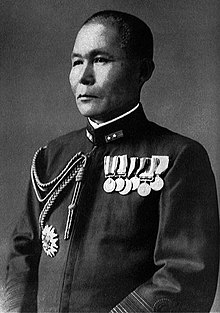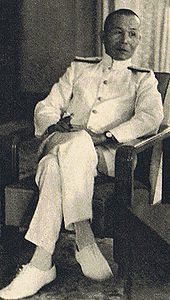Jisaburō Ozawa
This article includes a list of general references, but it remains largely unverified because it lacks sufficient corresponding inline citations. (June 2008) |
Jisaburō Ozawa | |
|---|---|
 Japanese Admiral Jisaburō Ozawa | |
| Native name | 小沢 治三郎 |
| Nickname(s) | "Gargoyle" |
| Born | October 2, 1886 Koyu District, Miyazaki, Japan |
| Died | November 9, 1966 (aged 80) Japan |
| Allegiance | |
| Service/ | |
| Years of service | 1909–1945 |
| Rank | |
| Commands held | Take, Shimakaze, Asakaze, Maya, Haruna 1st Fleet, 8th Cruiser Division, Southern Expeditionary Fleet, 1st Southern Expeditionary Fleet, 3rd Fleet, 1st Task Fleet, Naval General Staff, Combined Fleet[1] |
| Battles/wars |
|
| Awards | Order of the Sacred Treasure (2nd class) |
Vice-Admiral Jisaburō Ozawa (小沢 治三郎, Ozawa Jisaburō, October 2, 1886 – November 9, 1966) was an admiral in the Imperial Japanese Navy during World War II. He was the last Commander-in-Chief of the Combined Fleet.[2] Many military historians regard Ozawa as one of the most capable Japanese flag officers.[3]
Biography[]
Ozawa was born in rural Koyu County, Miyazaki prefecture on the island of Kyūshū, Japan.
Ozawa graduated from the 37th class Imperial Japanese Naval Academy on November 19, 1909, placing 45th in a class of 179 cadets. He performed his midshipman service on the cruisers Soya and Kasuga and battleship Mikasa, and was commissioned an ensign on December 15, 1910. He was promoted to sub-lieutenant on December 1, 1912 and to lieutenant on December 13, 1915.
As an ensign, Ozawa served on the destroyer , battleship Hiei and cruiser Chitose, and as a lieutenant, on Kawachi and Hinoki. He specialized in torpedo warfare in his studies; after his graduation from the Naval War College (Japan) in 1919 and promotion to lieutenant commander on December 1, 1921, he was given his first command, the destroyer Take. He subsequently commanded Shimakaze[1] and Asakaze. He served as chief torpedo officer on Kongō in 1925, and was promoted to commander on December 1 of the following year.
Ozawa served in various staff positions from 1925–1933, except for a one-year period in 1930 when he was assigned to visit the United States and Europe. He was promoted to captain on December 1, 1930, and on November 15, 1934, he was assigned command of the Maya and Haruna the following year.

On December 1, 1936, Ozawa was promoted to rear admiral.[1] He continued to serve in various staff positions, including Chief of Staff of the Combined Fleet in 1937 and Commandant of the Imperial Japanese Naval Academy. He was promoted to vice admiral on November 15, 1940.
Ozawa was one of leading advocates of naval aviation in the Imperial Japanese Navy. Ozawa was the first high-ranking officer to recommend that the Japanese aircraft carrier forces be organized into an air fleet so that they could train and fight together.
After the attack on Pearl Harbor, Ozawa became responsible for Japan's naval operations in the South China Sea as Commander in Chief of the IJN 1st Southern Expeditionary Fleet covering the invasion of Malaya. In early 1942 (January to March), his fleet was involved in the invasions of Java and Sumatra.[4]
In March–April 1942 he commanded the highly successful commerce raiding detachment during the foray into the Indian Ocean.[4]
On November 11, 1942, Ozawa was appointed Commander in Chief of the IJN 3rd Fleet,[1] relieving vice admiral Chūichi Nagumo as commander of Japan's carrier forces. Ozawa proved an aggressive and skilled commander, but was overwhelmed by the numerical and technological superiority of the United States at the Battle of the Philippine Sea on June 19–20, 1944 that proved to be a US Navy victory so crushing that its fighter pilots derisively nicknamed the battle, "The Great Marianas Turkey Shoot." After the battle, Ozawa retreated to Okinawa where he tendered his resignation — which was not accepted. Ozawa's strategic plan for the battle minimized the exposure of the Japanese carrier fleet by conducting carrier air raids on the US fleet at long range (exploiting the superior range of Japanese aircraft compared to their US counterparts) and, coupled with US admiral Marc Mitscher's aggressiveness was the primary cause for most of the US aircraft losses in the battle which were incurred due to extreme range at which they launched a counterattack against the retreating Japanese carrier fleet.

In October, what was left of Ozawa's carrier fleet fought at the Battle of Leyte Gulf[4] against the forces of Admiral William Halsey. Although he was the senior admiral at the Battle of Leyte Gulf, Ozawa was not given a leading command position since the Japanese battle plan was to sacrifice his force as a decoy so Admiral Takeo Kurita's Center Force could traverse San Bernardino Strait and freely fall upon MacArthur's invasion forces on the Leyte beaches. Nevertheless, Ozawa played his role intelligently and professionally until the end, although his carrier fleet ended its combat career off of the Philippines as little more than a bait force, flight decks empty for lack of planes and pilots. Despite the loss of all of his carriers, including his flagship the Zuikaku, Ozawa survived the battle along with most of his fleet.
On May 29, 1945, he accepted a position on the Imperial Japanese Navy General Staff,[1] and was the final CINC of the Imperial Japanese Navy until the end of the war in September 1945.[4] He refused a promotion to full admiral, and remained as vice admiral until the final dissolution of the Imperial Japanese Navy.
Ozawa, nicknamed 'The Gargoyle' (Onigawara) by his men, was commonly regarded as one of the three ugliest admirals in the Navy. At a time when the average Japanese male was 5.5 feet or under, Admiral Ozawa was 6 feet 7 inches tall. He also had a reputation of being both courageous and compassionate towards his men.[2]
Ozawa died on November 9, 1966 at the age of 80.[5]
Notes[]
- ^ Jump up to: a b c d e "Ozawa Jisaburo". Naval History via Flix.
- ^ Jump up to: a b Parshall, Jonathan. "Jisaburo Ozawa". Combinedfleet.com.
- ^ Evans, David C.; Mark R. Peattie (1997). Kaigun: Strategy, Tactics, and Technology in the Imperial Japanese Navy 1887-1941. Annapolis, Maryland: Naval Institute Press. pp. 531–532. ISBN 978-0-87021-192-8.
- ^ Jump up to: a b c d Klemen, L (1999–2000). "Vice-Admiral Jisaburo Ozawa". Forgotten Campaign: The Dutch East Indies Campaign 1941-1942.
- ^ Nishida, Imperial Japanese Navy
References[]
- "Ozawa, Jisaburo". Combined Fleet.com. Retrieved June 14, 2006.
- L, Klemen (2000). "Forgotten Campaign: The Dutch East Indies Campaign 1941–1942".
- Nishida, Hiroshi. "Ozawa, Jisaburo". Imperial Japanese Navy. Archived from the original on January 30, 2013. Retrieved June 14, 2006.
Further Reading[]
- Costello, Frank (2001). The Second World War. Harper Perennial. ISBN 0-688-01620-0.
- D'Albas, Andrieu (1965). Death of a Navy: Japanese Naval Action in World War II. Devin-Adair Pub. ISBN 0-8159-5302-X.
- Dull, Paul S. (1978). A Battle History of the Imperial Japanese Navy, 1941-1945. Naval Institute Press. ISBN 0-87021-097-1.
- Field, James A. (1947). The Japanese at Leyte Gulf;: The Sho operation. Princeton University Press. ASIN B0006AR6LA.
- Frank, Richard (2001). Downfall: The End of the Imperial Japanese Empire. Penguin. ISBN 0-14-100146-1.
- Gilbert, Martin (2004). The Second World War: A Complete History. Holt. ISBN 0-8050-7623-9.
- Keegan, John (2005). The Second World War. Penguin. ISBN 0-14-303573-8.
- Sheftall, M.G. (2005). Blossoms in the Wind: Human Legacies of the Kamikaze. NAL Caliber. ISBN 0-451-21487-0.
- Spector, Ronald (1985). Eagle Against the Sun: The American War With Japan. Vintage. ISBN 0-394-74101-3.
External links[]
- "Ozawa, Jisaburo". The Pacific War Online Encyclopedia. Retrieved June 14, 2006.
- Friedmann, Kenneth. "Ozawa, Jisaburo". Battle of Leyte Gulf. Archived from the original on February 6, 2006. Retrieved June 14, 2006.
- 1886 births
- 1966 deaths
- People from Miyazaki Prefecture
- Imperial Japanese Navy admirals
- Japanese admirals of World War II
